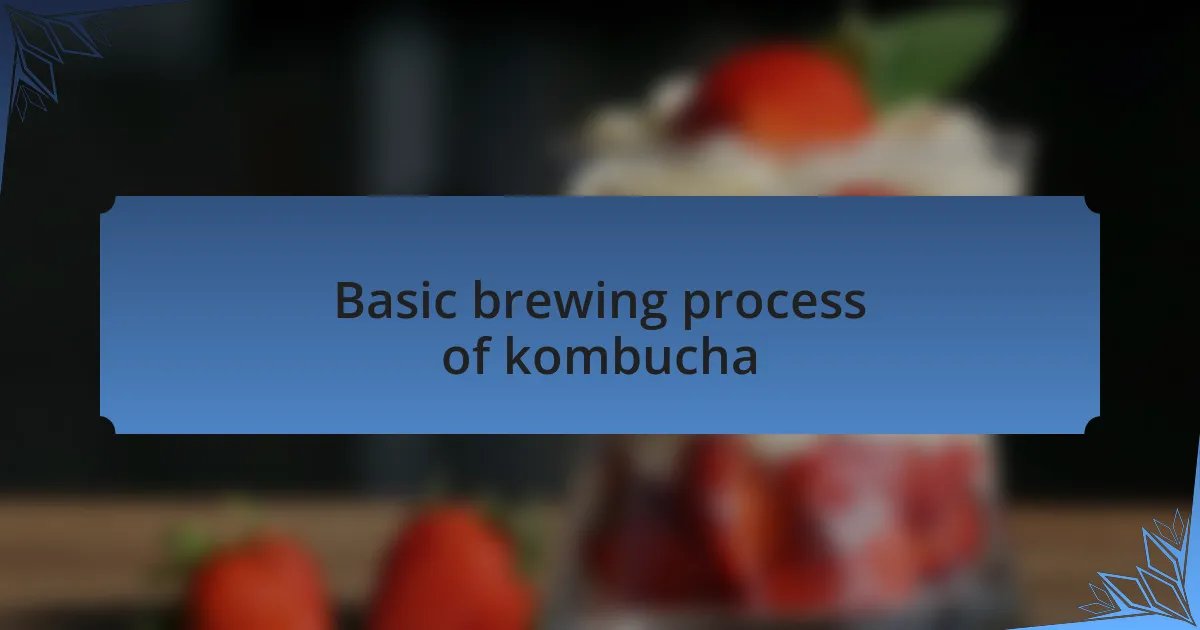Key takeaways:
- The fermentation process of kombucha involves a SCOBY introduced to sweetened tea, transforming it into a probiotic-rich drink over 7 to 14 days.
- Brewing kombucha at home is cost-effective, allows for flavor customization, and can improve gut health through the consumption of probiotics.
- Successful fermentation requires attention to temperature, fermentation time, and cleanliness to avoid contamination and undesirable flavors.
- Common challenges in brewing include maintaining ideal temperatures and timing the bottling to achieve the desired taste balance.

Understanding homemade kombucha
When it comes to homemade kombucha, understanding the fermentation process is crucial. The magic truly happens when you introduce a symbiotic colony of bacteria and yeast, or SCOBY, into sweetened tea. I remember my first batch—it sat on the counter, bubbling away, and the anticipation of that first sip felt thrilling.
As it ferments, kombucha transforms from a sweet tea into a tangy beverage packed with probiotics. Each sip contains a story of balance between sweet and sour, and I often find myself pondering: how does something so simple create such complex flavors? It’s the result of time and the tiny organisms hard at work, which always amazes me.
What I find fascinating is how brewing your own kombucha allows for endless customization. Want to add ginger for a spicy kick or berries for a fruity twist? It’s entirely up to you! Each flavor combination nurtures not just creativity, but also a deeper connection to what you’re consuming. How wonderful is it to savor a drink that you’ve crafted with your own hands?

Benefits of brewing kombucha
Brewing kombucha at home offers a unique opportunity to improve gut health. I can personally attest to the difference I felt after incorporating this fizzy drink into my routine. The probiotics, which are good bacteria, help with digestion and promote a healthy gut microbiome. Have you ever experienced that comforting feeling after a meal? That’s often your gut thanking you for making a wholesome choice.
Another significant benefit is the financial aspect. Initially, I was surprised to find how cost-effective brewing kombucha at home can be. Instead of paying high prices for store-bought bottles, I spent a fraction of that on tea and sugar. Now, every time I pop open a bottle I’ve brewed myself, there’s a sense of pride in knowing I’ve created something delicious without breaking the bank.
Then there’s the joy of experimenting with flavors. I remember the exhilaration of trying different ingredients; adding fresh herbs or citrus often led to unexpected delights. Isn’t it exciting to think that each brew can be a unique reflection of your taste? This creative freedom not only makes the process enjoyable but also personalizes your experience, stirring up emotions akin to those you feel when making anything special from scratch.

Essential ingredients for kombucha
To brew kombucha, the key ingredients are tea, sugar, water, and the SCOBY, which stands for Symbiotic Culture of Bacteria and Yeast. I remember the first time I saw my SCOBY float in the sweetened tea—like a living jellyfish dancing at the surface. It sparked both curiosity and excitement, knowing that this simple mixture would turn into a tangy, effervescent drink.
I use organic black or green tea, as these varieties provide a solid base and a rich flavor profile. Initially, I tried various tea blends and flavors, but there’s something about the classic black tea that feels comforting. Have you ever sipped a drink that reminded you of home? That’s what black tea does for me, blending tradition and taste effortlessly.
In addition to the main ingredients, the type of sugar matters. I prefer using organic cane sugar, as it’s vital for feeding the SCOBY during fermentation. The first time I experimented with different sugars, I noticed a significant change in the kombucha’s taste. Isn’t it fascinating how such a small choice can dramatically alter the outcome? Each ingredient plays a role, contributing to the ultimate experience of your homemade brew.

Basic brewing process of kombucha
Once you have your ingredients set, the brewing process begins with steeping the tea. I usually let it steep for about 15 minutes, allowing the flavors to develop fully. As the aroma fills the kitchen, I can’t help but feel a sense of anticipation—there’s something magical about transforming simple ingredients into something extraordinary.
After the tea cools down to room temperature, I mix in the sugar, stirring until it’s completely dissolved. The next step is introducing the SCOBY into the sweetened tea. I still remember the first time I carefully placed my SCOBY in the jar, holding my breath as I watched it bob and settle, knowing that this moment would kick off a fascinating fermentation process. Have you ever felt that thrill before? It’s like welcoming a new friend who is about to help you embark on a flavorful adventure.
The fermentation process typically takes 7 to 14 days, depending on your taste preference. I often sneak a taste around the week mark to gauge the flavor. It’s like a little surprise every time—each batch has its unique personality! The beauty of brewing kombucha is the learning curve; every batch teaches you something new, much like life itself.

Tips for successful fermentation
To achieve successful fermentation, maintaining the right temperature is crucial. I’ve found that a warm, dark space is ideal, ideally between 75°F and 85°F. When my kombucha sits in a drafty area, I notice it can slow down, and I can’t help but feel a bit disheartened while waiting for that perfect brew. What’s the point of rushing when good things take time?
Monitoring the fermentation time is another tip I swear by. I tend to check my brew around day five, looking for that subtle balance between sweetness and tartness. Sometimes, I’ve left it a day too long and ended up with an overly sour batch. It’s a constant dance of patience and anticipation—how do you know when to stop fermenting? For me, it’s all about trusting my palate and letting it guide me through.
Lastly, don’t forget about cleanliness! I remember the first time I neglected to sterilize my brewing equipment properly and ended up with a funky taste that ruined my enthusiasm for the whole process. This experience taught me that every little detail matters in fermentation, and keeping things clean can make all the difference in the quality of your kombucha. So, what’s your brewing ritual? Cultivating good habits can truly transform each batch into something you’ll look forward to savoring.

My favorite kombucha flavors
I’ve always had a soft spot for ginger-lemon kombucha. The zesty kick of ginger combined with the bright citrus flavor of lemon creates a refreshing burst that never fails to lift my spirits. It reminds me of sunny afternoons spent on my porch, sipping my favorite brew while listening to the gentle rustle of leaves. Have you ever experienced a flavor that just brings back the warmth of a memory?
Then there’s my go-to favorite, blueberry-lavender. The sweetness of the blueberries melds effortlessly with the calming notes of lavender, capturing an essence of serenity in every sip. I vividly recall the first time I tried this combination; it felt like an unexpected hug in a glass! It’s the perfect companion for those quiet evenings when I need to unwind after a long day.
Lastly, I can’t overlook the classic green tea with mint. The crispness of mint adds an invigorating aspect, offering a unique twist on the traditional taste. I often brew it to share with friends during gatherings—there’s something special about seeing their faces light up when they take their first refreshing sip. Which flavor do you think would surprise your taste buds the most?

Challenges faced in brewing kombucha
Brewing kombucha can be quite a journey, filled with unexpected hurdles. One of the primary challenges I faced was maintaining the right temperature during fermentation. Just like Goldilocks, my kombucha needed it “just right” – too warm, and it risked over-fermenting; too cool, and the process slowed down significantly. Have you ever experienced the frustration of waiting for something that just doesn’t seem to happen on time?
Another issue that often arises is contamination. I remember an instance when a batch turned out fizzy and odd-tasting because some rogue bacteria infiltrated my brew. It’s a little nerve-wracking, isn’t it? I learned the hard way that cleanliness is crucial; every utensil and jar must be sanitized. It makes me wonder how many first-time brewers give up after a few failed attempts due to this one challenge!
Lastly, timing can be a tricky element of the brewing process. I often find myself grappling with the decision of when to bottle my kombucha. If I bottle too early, it can be overly sweet and flat; if I wait too long, it becomes overly sour. It’s a delicate balance and a lesson in patience. Have you ever had to wait for something you were really excited about, only to realize you needed to exercise a little more patience?